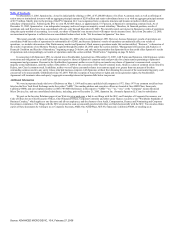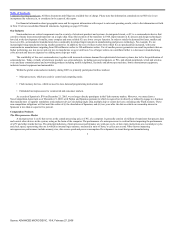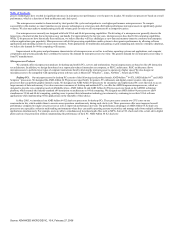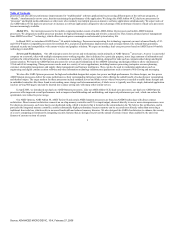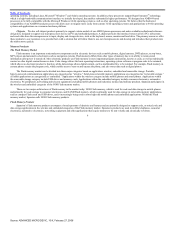AMD 2005 Annual Report Download - page 17
Download and view the complete annual report
Please find page 17 of the 2005 AMD annual report below. You can navigate through the pages in the report by either clicking on the pages listed below, or by using the keyword search tool below to find specific information within the annual report.
Table of Contents
competitors aggressively price their Flash memory products to increase market share. Competition may also increase if NOR memory vendors merge or
otherwise consolidate their operations. Furthermore, Spansion faces increasing competition from NAND Flash memory vendors in some portions of the
embedded and wireless market categories.
Moreover, competitors are working on a number of new technologies, including FRAM, MRAM, polymer and phase-change based memory technologies.
If successfully developed and commercialized as viable alternatives to Flash memory, these technologies could pose a competitive threat to Spansion. In
addition, Spansion and certain of its competitors have licensed Flash memory technology called NROM technology from a third party. NROM technology has
similar characteristics to MirrorBit technology, which may allow these competitors to develop Flash memory technology that is competitive with MirrorBit
technology.
To the extent that these or other competitive conditions adversely effect Spansion’s results of operations, our results of operations could also be adversely
affected.
Research and Development
We focus our research and development activities on product design and system and manufacturing process development. We have devoted significant
resources to product design and to developing and improving manufacturing process technologies. We also work with other industry leaders as well as public
foundations, universities and industry consortia to conduct early stage research and development. For example, we conduct our microprocessor manufacturing
process development primarily through our joint development agreement with IBM. We are also a joint venture partner with Infineon Technologies AG and
Toppan Printing Co., Ltd. for research and development related to optical photomasks that we use during microprocessor manufacturing. We are also a member
with Infineon, the Fraunhofer-Gesellschaft research institution, the German Ministry of Education and Research and the Free State of Saxony in the Fraunhofer
Center for Nanoelectronic Technology, the CNT, in Dresden, Germany. The CNT is a joint development effort that conducts research and development projects
that focus on developing improvements in semiconductor processing technology particularly on 300-millimeter technology.
We are currently focusing on delivering the next generation of microprocessors and on advanced manufacturing process technologies, including
implementing 65-nanometer technology and continuing development of our 45-nanometer technology. In order to remain competitive, we must continue to
maintain our technology leadership. As of December 25, 2005, our total research and development staff consisted of approximately 2,700 employees. Because
Spansion’s IPO closed on December 21, 2005, Spansion’s research and development staff is not included in the number of employees listed above. Our research
and development expenses for 2005, 2004, and 2003 were $1,144 million, $935 million and $852 million. For more information, see “Management’s Discussion
and Analysis of Financial Conditions and Results of Operations.”
Microprocessors
We conduct product and system research and development activities for our microprocessor products in the United States with additional design and
development engineering teams located in Germany, China, Japan and India. In December 2005, we announced the opening of the Korea Technology
Development Center. The center will focus on helping local customers and partners develop customized embedded processor platforms for various digital
consumer devices, including WiBro terminals, digital media broadcast solutions, personal media players, HDTV and Internet access solutions.
We conduct our microprocessor manufacturing process development activities primarily through our joint development agreement with IBM. In August
2005, we and IBM executed the Second Amended and Restated “S” Process Development Agreement. Under this agreement, we agreed to continue to jointly
develop new process technologies, including 32-nanometer, 22-nanometer and certain other advanced technologies, to be
12
Source: ADVANCED MICRO DEVIC, 10-K, February 27, 2006


